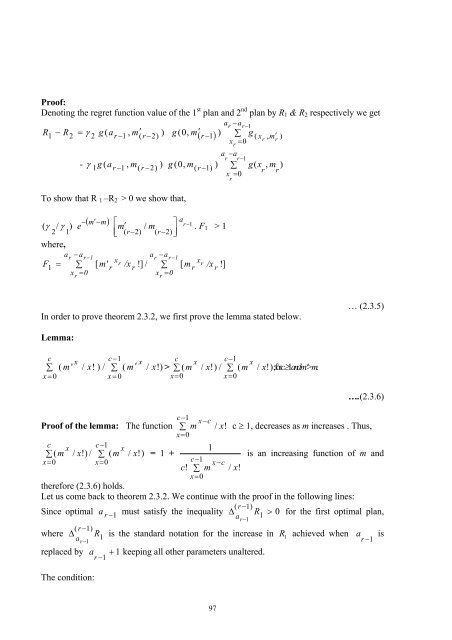Multiattribute acceptance sampling plans - Library(ISI Kolkata ...
Multiattribute acceptance sampling plans - Library(ISI Kolkata ...
Multiattribute acceptance sampling plans - Library(ISI Kolkata ...
You also want an ePaper? Increase the reach of your titles
YUMPU automatically turns print PDFs into web optimized ePapers that Google loves.
Proof:<br />
Denoting the regret function value of the 1 st plan and 2 nd plan by R 1 & R 2 respectively we get<br />
a −<br />
R1 − R2<br />
= γ<br />
2<br />
g ( a r −1<br />
, m′<br />
( r −2<br />
) ) ( 0,<br />
−1<br />
(<br />
′<br />
−1 ) )<br />
r<br />
ar<br />
g m<br />
r ∑ g<br />
( x , ′ )<br />
x = 0<br />
r<br />
mr<br />
a −a<br />
- γ<br />
1g<br />
( a r −1<br />
, m(<br />
r −2<br />
) ) ( r r<br />
g 0, m( r −1 ) )<br />
x = 0<br />
To show that R 1 –R 2 > 0 we show that,<br />
( γ / )<br />
2 γ − ( m′−m<br />
e<br />
) ⎡<br />
/<br />
⎤<br />
a<br />
m ′ m<br />
r−1<br />
. F 1 > 1<br />
1 ⎢⎣ ( r−2)<br />
( r−2)<br />
⎥⎦<br />
where,<br />
ar<br />
− ar−1<br />
ar<br />
− a<br />
x<br />
r−1<br />
1 = ∑ [ r<br />
x<br />
F<br />
m' !] / ∑ [ r<br />
r /x r<br />
m r /x r !]<br />
x = 0<br />
x = 0<br />
r<br />
r<br />
r<br />
∑ − 1<br />
r<br />
g ( x , )<br />
r m r<br />
In order to prove theorem 2.3.2, we first prove the lemma stated below.<br />
… (2.3.5)<br />
Lemma:<br />
c<br />
∑ ( m ' / x!<br />
) / ∑ ( m ′ / x!)<br />
> ∑ ( m / x!)<br />
/ ∑ ( m / x!)<br />
; for c ≥ 1 and m′ > m .<br />
x = 0<br />
x<br />
c −1<br />
x = 0<br />
x<br />
c<br />
x=<br />
0<br />
x<br />
c−1<br />
x=<br />
0<br />
x<br />
….(2.3.6)<br />
c−1<br />
x−c<br />
Proof of the lemma: The function ∑ m / x!<br />
c ≥ 1, decreases as m increases . Thus,<br />
x=<br />
0<br />
c<br />
x<br />
c−1<br />
x<br />
1<br />
∑ ( m / x!) / ∑ ( m / x!)<br />
= 1 +<br />
is an increasing function of m and<br />
x=<br />
0<br />
x=<br />
0<br />
c−1<br />
x−c<br />
c!<br />
∑ m / x!<br />
x=<br />
0<br />
therefore (2.3.6) holds.<br />
Let us come back to theorem 2.3.2. We continue with the proof in the following lines:<br />
( r 1)<br />
Since optimal a<br />
r −1<br />
must satisfy the inequality ∆ R1<br />
> 0 for the first optimal plan,<br />
( r −1)<br />
a r<br />
− a r −1<br />
where ∆ R1<br />
is the standard notation for the increase in R 1<br />
achieved when<br />
−1<br />
replaced by a 1<br />
r −1 + keeping all other parameters unaltered.<br />
The condition:<br />
a is<br />
r −1<br />
97
















